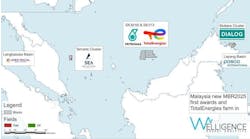Offshore West Africa has become one of the industry’s most active E&P arenas, not only in terms of activity, but also in advancing new field development concepts.
As a case in point, considerBP’s Greater Plutonio field, due onstream next year. It could be the first of several cluster developments for BP offshore Angola. All are located in deepwater blocks 18 and 31, where the company has drilled a long sequence of discoveries since 1999. Experience from Girassol in particular has been factored into Greater Plutonio’s subsea concept.
As with Girassol, Greater Plutonio will be produced via an FPSO, with incoming production passing through a self-standing bundled riser tower. The tower structure, encasing three production risers, will be connected to the FPSO via flexible pipes. The risers will be linked to a network of flow lines tying in 43 subsea wells, one of the biggest and most complex schemes attempted by BP anywhere.Jeremy Beckman, Editor - Europe, gives full details of the project in his report beginning on page 40.
Meanwhile,Cabinda Gulf Oil Co. Ltd. (Cabgoc), a subsidiary of Chevron, has achieved first oil production from the $2.2-billion Benguela, Belize, Lobito, and Tomboco (BBLT) development, the first compliant tower outside the Gulf of Mexico.
Chevron and partners are undertaking a two-phased program to develop the BBLT project, located on Angola’s block 14 in 1,300 ft of water. Phase 1 includes drilling and completion of more than 30 developments wells from the recently installed 12-pile, 40-slot integrated drilling and production steel compliant tower platform.
According to Chevron, the compliant piled tower (CPT) is the first application of this structural technology outside the Gulf of Mexico. Phase 2 calls for exploitation of the Lobito and Tomboco fields via subsea wells tied back to the BBLT central hub. First production from Phase 2 is expected in early 2007, followed by combined peak production of 200,000 b/d by 2009.Senior Editor David Paganie details the field development concept and execution beginning on page 44.
Finally, E&P spending off West Africa continues to grow. Since the Bonga discovery in 1996, deepwater development in Africa has increased at a steady and strong pace. And over the next five years, West Africa is expected to be the leader in deepwater E&P spending, representing about 40% of the world total.
That’s the forecast from research firmDouglas-Westwood, as reported by International Editor Pam Boschee in this month’s West Africa report, beginning on page 48.
Deepwater development projects already in progress for the period to 2010 include Chevron’s Agbami, ExxonMobil’s Akpo, Bosi, and Erha projects, and Total’s Usan/Ukot, all of which are located offshore Nigeria.
Offshore Angola, we discussed Chevron’s BBLT development and BP’s Greater Plutonio field. BP is evaluating options for its block 31 discoveries, while Total is moving ahead with development of the Rosa and Lirio fields.
Even as West Africa’s E&P growth continues, recent events in Nigeria show that geopolitical challenges in this region also continue. Although the short-term result has been to help force up prices and drive some buyers to search for more secure purchase options, their long-term effect remains to be seen.
Top 10 drilling contractors
Worldwide rig demand is strong and utilization of the marketed fleet is virtually 100% in every geographic region for every rig type. Day rates have reached all-time highs, and further increases are expected. Operators and rig owners alike are experiencing record profits, and as a result, operator spending will increase this year.
Record high oil and natural gas prices were not only reached but also sustained for much of the past year. The number of new rig orders placed last year was staggering, so much so that some are now wondering if once again contactors are overbuilding.
To analyze the state of the drilling sector, we called onTerry Childs, Rig Data Manager for ODS-Petrodata, Inc. His report, done exclusively for the readers of Offshore, begins on page 36.


